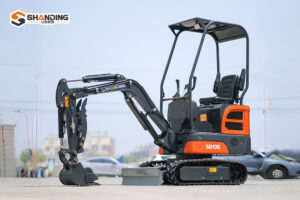In today’s rapidly developing fields of construction, agriculture, and municipal engineering, small excavators have become indispensable equipment for various construction operations due to their flexibility, versatility, and affordability. Whether laying pipes in confined urban spaces, landscaping projects, agricultural water conservancy projects, or small-scale mining, choosing a small excavator that suits your needs is crucial.
Small Excavator Market Overview and the Importance of Purchasing: Small excavators (generally referring to excavators with a working weight between 1 and 13 tons) have shown sustained growth globally in recent years. According to industry statistics, small excavators now account for approximately 35% of the total construction machinery market, with an annual growth rate of approximately 8-10%. This growth is primarily driven by factors such as accelerated urbanization, increasing demand for rural infrastructure construction, and rising labor costs. Compared to traditional large excavators, small excavators offer significant advantages: their compact size allows for flexible operation in confined spaces; their low fuel consumption and economical operating costs; their versatility, enabling them to perform various functions such as digging, crushing, drilling, and grabbing by replacing different attachments; and their ease of transportation, requiring no specialized vehicles for transport. These features make mini excavators an ideal choice for small and medium-sized engineering projects, agricultural operations, and municipal maintenance. However, the wide variety of mini excavator brands and models on the market, with varying performance specifications and a wide price range, can make purchasing a confusing experience for many users. An unsuitable mini excavator can lead to low efficiency, high maintenance costs, and even safety hazards. A poor choice not only fails to meet project requirements but can also waste money. Therefore, understanding how to choose the most suitable mini excavator for your needs is crucial.


Determining Needs: The First Step in Mini Excavator Selection The mini excavator selection process should begin with a clear understanding of your needs. Different projects and work environments require significantly different performance from a mini excavator. Blindly pursuing high specifications or a low price can lead to wasted resources or inadequate performance. When determining your needs, consider the following key factors: The project type and the nature of the work are primary considerations. If you primarily work in the agricultural sector, such as trenching and orchard maintenance, a 5-8 ton mini excavator may be sufficient. However, for foundation excavation on a small construction site or pipeline laying on municipal roads, an 8-13 ton mini excavator will be more efficient. For multi-functional operations requiring frequent attachment changes (such as simultaneous excavation, crushing, and grabbing), choose a model with a rich hydraulic system configuration and high auxiliary oil flow. The Shanding Group SD15E mini excavator specifically considers these multifunctional needs, offering a wide range of attachment ports.
Working conditions are also crucial. For narrow urban lanes or indoor operations, a compact size and low noise design are crucial. In mines or on outdoor construction sites, greater maneuverability and durability are essential. If you frequently work on soft ground (such as farmland or wetlands), choosing a model with wider tracks or rubber tracks can effectively reduce ground pressure and prevent the equipment from sinking. The Shanding SD15E offers a variety of track configuration options to accommodate varying ground conditions. Frequency of use and project duration requirements directly influence the choice of equipment reliability and efficiency. For occasional individual users or small farms, an economical entry-level model may be more suitable. Professional contractors or engineering firms with frequent operations, on the other hand, will need to choose a mid- to high-end model with stable performance and extended maintenance intervals to minimize downtime.
The SD15E features reinforced structural components and an optimized maintenance design, making it particularly suitable for high-frequency, long-duration operations. Budget is naturally an unavoidable factor. Mini excavator prices range from hundreds of thousands to several hundred thousand yuan, and it’s important to balance the initial purchase cost with the long-term operational costs. It’s also important to note that lower-priced equipment may lack fuel efficiency, durability, or after-sales service, ultimately resulting in a higher total cost of ownership. The Shanding SD15E achieves excellent value for money while maintaining a reasonable price through optimized design and carefully selected components.
Operator skill level should also be considered. For users lacking skilled operators, choosing a model with a simplified control system and more automated features can reduce operational difficulty and improve work efficiency. The SD15E features an ergonomic control system and intuitive instrument display, making it easy for even novice operators to quickly master the operation.
By thoroughly evaluating the above factors, you can initially determine the required mini excavator’s tonnage range, power type (diesel/electric), travel method (crawler/wheeled), and key performance parameters, laying the foundation for subsequent model selection.




